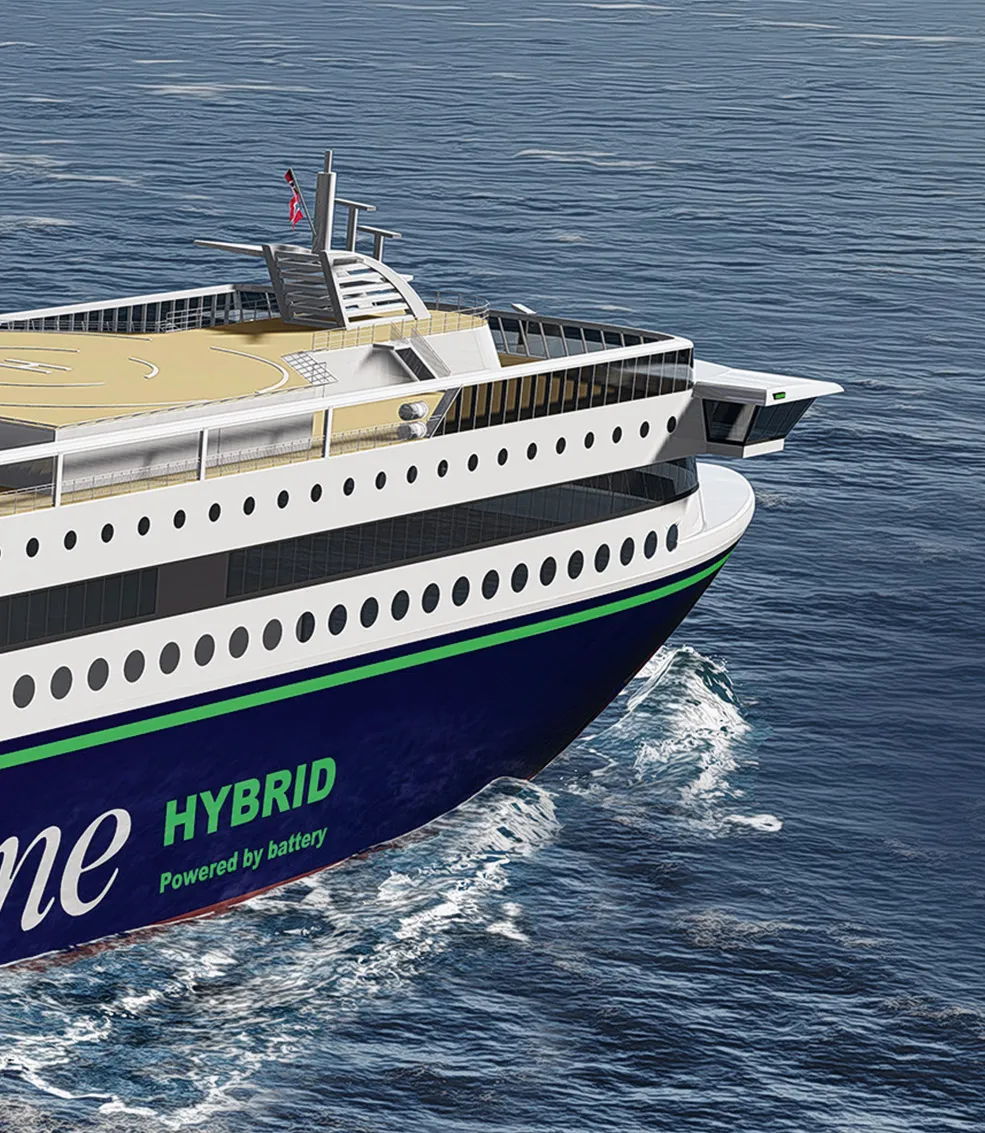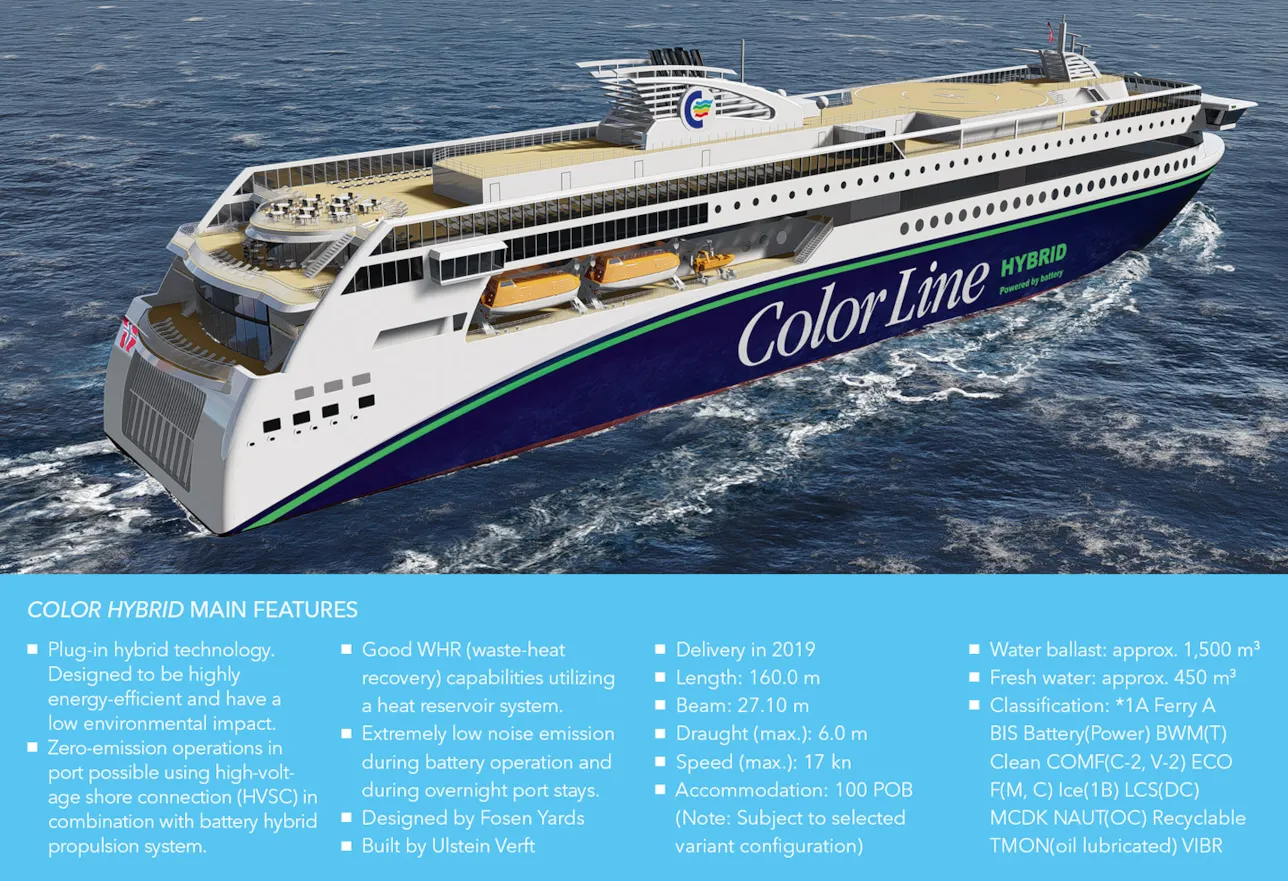Clean air in the fjord
Maintaining its focus on advanced environmental technology for its new ships, Color Line has ordered the world’s biggest hybrid ferry. The vessel will be able to operate exclusively on electric power while in Sandefjord and in the Strømstad area.
The vessel with the working title Color Hybrid is a ro-pax ferry, a new segment for Ulstein Verft where the ship will be build. Ulstein Group, with its subsidiaries Ulstein Verft, Ulstein Design and Solutions, and Ulstein Power and Control has been a major player in the design and construction of offshore vessels for decades. “When the offshore market almost disappeared overnight, we had to look into new ways and segments to utilize our 100 years of knowledge and competence,” says Kristian Sætre, Managing Director and COO Shipbuilding from Ulstein, explaining his company’s expansion into the ro-pax market. “Participating in the Color Hybrid tender and project has given us a very good position in this new segment. Backed by our comprehensive competence and our yard facilities, our ambition is to become a significant actor in designing and building ro-pax vessels and smaller cruise vessels,” he continues. The yard is well prepared to build this vessel type since its shipyard facilities fit the construction demands very well with regards to both dock and crane capacities, and expertise from other segments.
The ferry Color Hybrid will be classed by DNV GL. The agreement with the class society is normally one of the first contracts signed after a shipbuilding contract has been confirmed. From that stage on, DNV GL accompanies the entire process until the ship leaves the shipyard. Joint meetings and workshops as well as mandatory and mutually agreed surveys make sure the design parameters are in compliance with the applied rules. “Quite frequently we also rely on DNV GL experts as consultants when questions arise. We value DNV GL as a partner, and we have a common goal: to hand over a ship to the customer which fulfils his expectations,” Sætre underlines the role of class. “It is important to us to be part of this innovative project, which rewards us for the effort we have put into the development of our additional class notation for battery power, and for various studies we have participated in to promote the use of batteries as an alternative power source,” says Helge Hermundsgård, Business Development Manager at DNV GL. The additional class notation Battery (Power) is mandatory for vessels using battery power for propulsion during normal operation or as a redundant power source. The Battery (Power) notation confirms that the battery installations in a vessel meet increased safety requirements.

Award-winning design
Color Hybrid is a plug-in hybrid using both diesel and electrical power. The batteries are recharged with green electricity from the company’s own shoreside facilities at the Sandefjord dock. They can also be recharged on board using the ship’s own generators.
“There is a specific functional concept and philosophy behind the hybridization of Color Hybrid,” Sætre explains. “We have found that in almost all projects we work on these days, battery power is taken into consideration as an option, regardless of the segment.” Sætre also points out there is a trend toward hybrid vessels. In a
typical arrangement there is a dedicated space for battery banks of a certain size. To truly benefit from a battery installation there needs to be an operational philosophy, such as operating silently in certain conditions, utilizing the battery under peak loads to avoid having to start extra generators or to minimize the required generator capacity, or sailing in certain areas without polluting the air. “The investment in a hybrid solution may be high. Ulstein will assist customers in deciding whether and to what extent this investment would be beneficial,” Sætre points out. For vessels being prepared for future utilization of batteries, the yard can design the relevant components to minimize the cost of the actual battery installation and configuration at a later stage. While in the waters of the Sandefjord, Color Hybrid will operate solely on battery power. No emissions of harmful greenhouse gases or nitrogen and sulphur compounds will harm this area. What is more, the exterior noise level at low speed and while moored, measured at 100 metres distance from the vessel, will be lower than that of a normal conversation. DNV GL’s class notation “Clean” confirms the vessel’s enhanced environmental design and performance standards.
Fosen Yard has designed the hybrid ferry in close cooperation with Ulstein Verft and Color Line. “Fosen Yard has extensive
experience with such vessels, and we work together to achieve optimum results,” Kristian Sætre emphasizes. Design manager Per Edvin Tande of Fosen Yard says Color Hybrid will feature a new hull design. “There is a new and improved hull design which benefits from our experience and knowledge gained in past projects. Energy and environmental concerns are the driving design factors for the equipment on board the new ferry,” says Tande. The battery package has a capacity of about 5 MWh (megawatt hours), enabling the vessel to manoeuvre or sail at speeds of 0-12 knots for up to 60 minutes. The waste-heat recovery system on board will use a heat reservoir system.
In May 2017 the design won the Next Generation Ship Award, which honours the most promising design for ships that will be at sea in the coming decade. The jury explicitly praised the good and professional cooperation between the three companies from day one with a focus on innovation and greener technology.


Biggest hybrid ferry to date
The natural environment is an accelerator to Color Line, whose company has installed shore power facilities in Oslo, Larvik and Kristiansand. With Sandefjord already established as a recharging port, all Norwegian Color Line ports provide access to shore power. “Our ambition is to be a leader in European short-sea shipping, and Color Hybrid is new proof of this,” says Trond Kleivdal, CEO of Color Line.
With a length of 160 metres, Color Hybrid will have the capacity to carry 2,000 passengers and around 500 vehicles, making the vessel the world’s biggest hybrid ferry, with almost double the capacity of the ship she will replace. The new vessel will be built according to Norwegian flag requirements and registered in the Norwegian Ordinary Ship Register (NOR).
Rolls-Royce will supply four Bergen B33:45L diesel engines to power the new hybrid ferry. The delivery of the engines is scheduled for March. Color Hybrid will be put into service between Sandefjord, Norway, and Strømstad, Sweden, in summer 2019.
